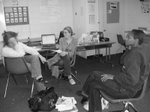Best teaching experience -
I've had so many, but I'll just choose one. I worked at St. Andrew’s Priory where I taught SS and English to 6th graders. I started off the year with giving them roles, rules and procedures. But I gave them some “fire” about their leadership within the school. Students loves doing projects and presented with such knowledge on the subject. They encouraged each other and resolved their own conflicts. I had the freedom build my own curriculum and model best practices to other teachers. I create innovative tools to help other students and teachers; curriculum maps, student portfolios, project based examples, class council strategies and procedures...
My worst teaching experience ever!
KCS where I had 7th grade students. I hated it there because I was unsupported by the principal, by her chosen few teachers, and by one particular parent who had a political agenda. Since the principal was planning a retirement soon, there were a few of her teachers who would spill anything you said to them in confidence. One teacher used me to get “Asst. Principal” title because she "found" me to replace a teacher who quit after a month of school. One parent and family was mentally abusive. Mom invited me to their home and uncomfortably “coddled” me; then days later verbal attacked me in front of my principal; and the principal said nothing during the incident. I found out by an email the parent was using me to expose the school, and used the verbal attack to gain a PTA position that same day. One student I had was physically abusive to two other students. When I reported his behavior to the principal, I was chastised for having no classroom management. Mind you, she never visited my classroom! The reality was there were no consequences for suspendable behaviors because it had previously been handled "under the carpet". Eventually, I had to call the police, although was written up by the principal for calling them. Later that year, two students were so traumatized, they tried to commit suicide. These are just a few examples of the autrocities at this school. It was a spiritually and emotionally draining year. Needless to say, I left at the end of the year.
Sunday, January 15, 2006
Book Review-The Courage to Teach – Carrie, Mike, Monica
Although teachers choose their profession because they are passionate about students and teaching, many lose heart, and thus have little to give to our students. Palmer explains this phenomenon guides teachers to reconnect teachers with that passion and become present in the classroom, connecting with students and learning. Some suggestions include using a subject-centered approach and building learning communities among stakeholders.
Book Review-Race, Class, and Power in School Restructuring: Rashawn, Cara, Frank
Can teacher collaboration and development improve African American students? Not really, without addressing the political aspect. Restructuring involves, untracking courses, professional communities must be created. 5 elements of professional practice that deprivatized practice, collaboration, reflective dialogue. Shared values: what does community care about? But what if teachers value the traditional society? Is the focus for kids to learn or to control them? Teacher collaboration-buzz words. But that’s only teachers meeting. Truly it means everyone having a voice, otherwise, change won’t take place. Desegragation was only focused on race and color, but not looking in the curriculum ie Gates program, tracked courses, etc.
Culturally responsive teaching-5 elements, devel cultural diversity knowledge base, learning community, cross-cultural communications, cultural diverse curriculum.
Culturally responsive teaching-5 elements, devel cultural diversity knowledge base, learning community, cross-cultural communications, cultural diverse curriculum.
Thursday, January 12, 2006
Schools that Learn - School Vision Ch 9
School Vision: p289-324 3 purposes: address pent-up tensions over current problems and concerns; be generative = be able to talk about deepest hopes and desires for children and community to find a sense of hope and mutual trust; in herent satisfaction of re-creating the school together, with one another’s support (including the support of those whom they have mistrusted in the past)
p. 59 Draw forth Personal Vision
9-year conversation process involving meetings with parents – 1-2 meetings a week every week in the fall visiting people in their homes
Exercises to draw forth mental models – see activity p293-295
25-year conversation process for educators in a school- after parent sessions, hold half-day workshops and divide into subgroups, based on key themese
Community vision meetings to bring the whole school community together
An implementation and follow through process
p. 59 Draw forth Personal Vision
9-year conversation process involving meetings with parents – 1-2 meetings a week every week in the fall visiting people in their homes
Exercises to draw forth mental models – see activity p293-295
25-year conversation process for educators in a school- after parent sessions, hold half-day workshops and divide into subgroups, based on key themese
Community vision meetings to bring the whole school community together
An implementation and follow through process
Saturday, January 07, 2006
Taylor, K. “Through the Eyes of Students” & the Achievement Gap video
The author suggests you show students where they are, have ‘real’ discussions as to why they are there and map out a plan, implementing high expectations, to assist them in getting to the next level. This helps shape the culture for both students and teachers.
Subscribe to:
Posts (Atom)

